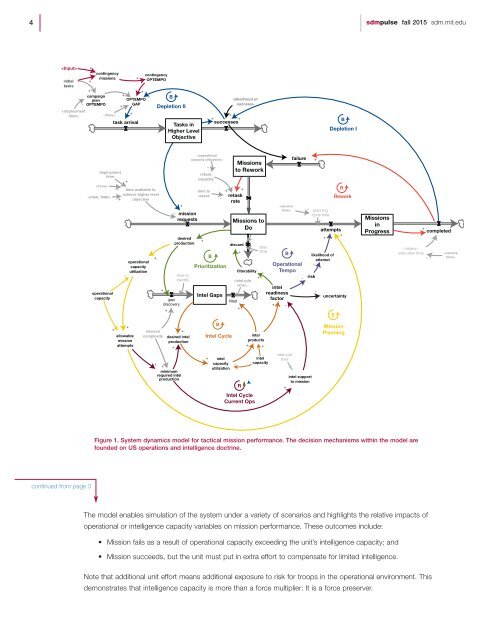sdm pulse
SDM-Pulse-Fall-2015
SDM-Pulse-Fall-2015
Create successful ePaper yourself
Turn your PDF publications into a flip-book with our unique Google optimized e-Paper software.
4 <strong>sdm</strong><strong>pulse</strong> fall 2015 <strong>sdm</strong>.mit.edu<br />
<br />
initial<br />
tasks<br />
<br />
+<br />
+<br />
+<br />
campaign<br />
plan<br />
- OPTEMPO<br />
contingency<br />
missions<br />
+<br />
+<br />
OPTEMPO<br />
GAP<br />
+<br />
<br />
+<br />
task arrival<br />
+<br />
contingency<br />
OPTEMPO<br />
-<br />
<br />
B<br />
Depletion II<br />
Tasks in<br />
Higher Level<br />
Objective<br />
+<br />
+<br />
+<br />
successes<br />
<br />
B<br />
Depletion I<br />
deployment<br />
time<br />
<br />
<br />
operational<br />
capacity<br />
+<br />
- time available to<br />
achieve higher level<br />
+ objective<br />
-<br />
+<br />
+<br />
allowable<br />
mission<br />
attempts<br />
operational<br />
capacity<br />
utilization<br />
+<br />
+<br />
mission<br />
complexity<br />
gap<br />
discovery<br />
+<br />
+<br />
desired intel<br />
production<br />
+<br />
+<br />
+<br />
minimum<br />
required intel<br />
production<br />
<br />
-<br />
retask<br />
capacity<br />
Intel Gaps<br />
B<br />
Intel Cycle<br />
+<br />
intel<br />
capacity<br />
utilization<br />
Missions<br />
to Rework<br />
filled<br />
+<br />
-<br />
intel<br />
products<br />
+ +<br />
intel<br />
capacity<br />
intel<br />
readiness<br />
factor<br />
+ -<br />
intelcyle<br />
time<br />
failure<br />
time to +<br />
+<br />
<br />
Rework<br />
+<br />
- planning<br />
- mission<br />
cycletime<br />
requests<br />
Missions to<br />
Do<br />
<br />
attempts<br />
+<br />
desired<br />
+<br />
+<br />
production<br />
discard<br />
filter<br />
B<br />
+ time<br />
B<br />
likelihood of<br />
attempt<br />
-<br />
Prioritization<br />
Operational<br />
filterability Tempo<br />
timeto<br />
+ - risk <br />
R<br />
Intel Cycle<br />
Current Ops<br />
intel support<br />
to mission<br />
+<br />
+<br />
-<br />
uncertainty<br />
B<br />
Mission<br />
Planning<br />
Missions<br />
in<br />
Progress<br />
mission<br />
executiontime<br />
+<br />
completed<br />
-<br />
<br />
Figure 1. System dynamics model for tactical mission performance. The decision mechanisms within the model are<br />
founded on US operations and intelligence doctrine.<br />
continued from page 3<br />
The model enables simulation of the system under a variety of scenarios and highlights the relative impacts of<br />
operational or intelligence capacity variables on mission performance. These outcomes include:<br />
• Mission fails as a result of operational capacity exceeding the unit’s intelligence capacity; and<br />
• Mission succeeds, but the unit must put in extra effort to compensate for limited intelligence.<br />
Note that additional unit effort means additional exposure to risk for troops in the operational environment. This<br />
demonstrates that intelligence capacity is more than a force multiplier: It is a force preserver.


